Renault Grand Scenic 1.4 TCe 130 Dynamique & 2.0 dCi 160 Review
Renault Grand Scenic 1.4 TCe 130 Dynamique & 2.0 dCi 160
Jeremy casts his critical eye over the Renault Grand Scenic and its TomTom based sat-nav.
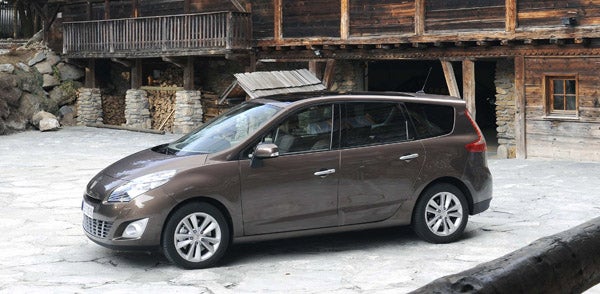
Verdict
Renault Grand Scenic 1.4 TCe 130 Dynamique: £18,595 OTR
Renault Grand Scenic 2.0 dCi 160 Privilege: £22,695 OTR
Banging in hot laps around the infamous Nurburgring in a Porsche 911 Carrera or blitzing Italy’s Stelvio Pass onboard a Pagani Zonda are all very well. But back in the real world, what most people really want from their car is safe, efficient and comfortable family transport. Arguably the most finely optimised tool for getting that job done is an MPV, otherwise known as the humble people carrier.
Within the broader people carrier market it’s probably the compact MPV that represents the sweet spot in terms of value, comfort and spaciousness. Renault, of course, has long been a trail blazer in MPVs and pretty much invented the compact variant, known in the industry vernacular as C-segment MPVs, in 1996 with the original Megane Scenic.
In 2003, Renault upped the ante with the Grand Scenic, a stretched version of the Megane-based MPV with a longer wheelbase, larger rear overhang and seating for seven. All told, Renault has flogged no less than 3.2 million Scenics. It’s an extremely important model for the French manufacturer, in other words.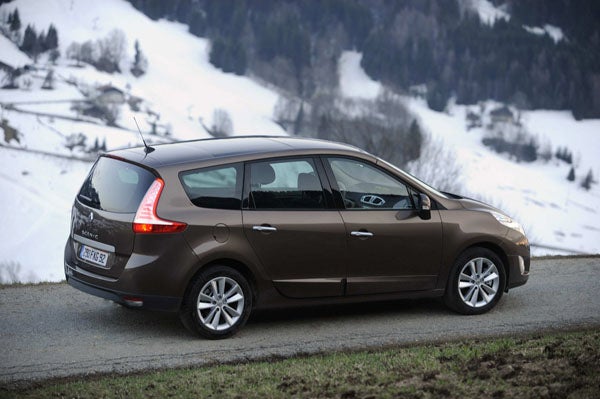
Earlier this year, Renault rolled out an all-new Megane and that means there’s also a new Grand Scenic. With the latest model, Renault is aiming to lift its compact MPV game even further with more comfort, more space, better driving dynamics and an infotainment upgrade that leverages its new partnership with aftermarket navigation specialists TomTom.
For our first taste of the new Grand Scenic, Renault gave us access to a fleet of test cars in 2.0L diesel and 1.4L petrol trim. The latter engine is new to Renault and sports soft turbo charging designed to fill out the torque curve while keeping emissions and fuel consumption under tight control.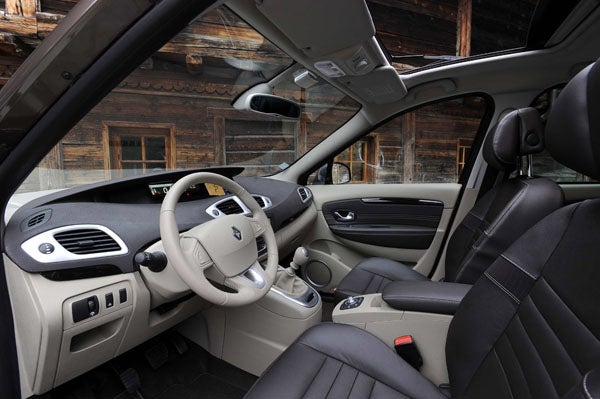
First impressions are of a more substantial, up market car inside and out, even if it’s hardly a beautiful vehicle in conventional terms. Still, the premium vibe is probably just as well, what with prices starting well north of £15,000 and extending beyond £20,000. As a private purchase, the latest Grand Scenic is a significant investment.
A pair of dash-mounted LCD screens forms the centerpiece of the Grand Scenic’s upgraded infotainment kit. The first display is an extremely wide and shallow panel and replaces what would be the instrument cluster in most cars. That means everything from the speedometer to the rev counter and fuel level gauge are rendered virtually.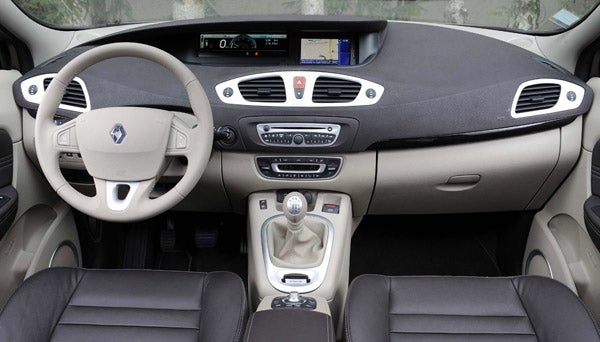
Done well, this approach can be extremely effective as Mercedes recently proved with its latest S-Class. Indeed, it’s very likely more and more cars will feature it in future. In the new Grand Scenic, however, it’s rather less successful. For starters, the screen installation looks a bit cheap. Partly that’s thanks to the rather mean proportions of the panel itself, but the excessive amount of dead space surrounding it hardly helps, either.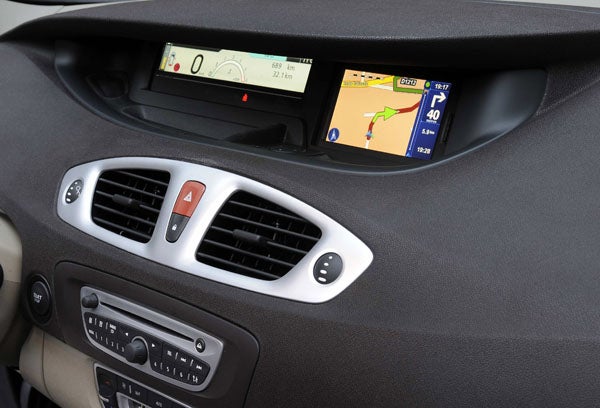
Unfortunately, Renault decided to cheapen things further with a chintzy “TFT DISPLAY” graphic below the panel. Frankly, it’s redolent of 1980s boom boxes and their ubiquitous “graphic equalizers”. Renault would be well advised to realise that in 2009 nobody is impressed by the mere presence of a TFT display. Making matters worse, the on-screen graphics also smack of cheap hi-fi rather than high end automotive fare. Overall, the look is dated and messy, which is never a good thing for a brand new product.
Nor, sadly, is it terribly easy to read, despite the fact that Renault has provided several colour and contrast options for users to choose from. Not only is the interface visually noisy, but the meager vertical size of the display also creates problems, particularly when accessing the Grand Scenic’s multimedia functions.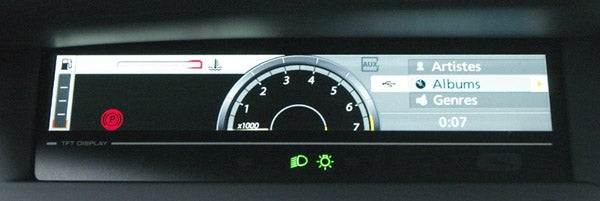
That’s a shame, because the latest Grand Scenic is fairly well specified when it comes to digital music playback. Okay, it doesn’t have a hard drive for local storage of music files. It doesn’t support video playback, either. But when fitted with the optional USB port (located in the centre console), it does boast both native iPod support and the ability to play music files from a mass storage device.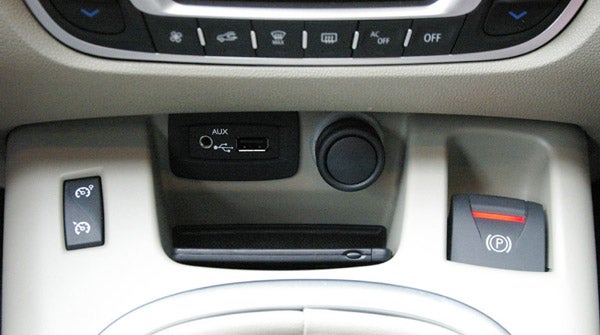
Strictly speaking, the system does an effective job on both counts. It correctly recognised our USB memory stick and first-gen iPod Nano and we like the fact that it immediately takes users to the playback interface upon connection. The problem comes when you attempt to navigate large libraries of music. There’s only enough space on the main display for three rows of text, forcing you to scroll, scroll and scroll again.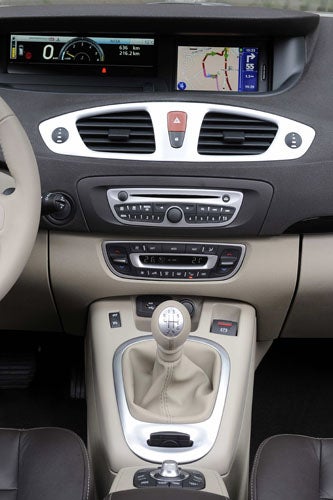
Then there are the slightly fiddly, cheap and confusing dash mounted infotainment controls. If there’s a logic and consistency to them, we failed to uncover it during our relatively brief time with the car. Users are further confused by the fact that the controls for and the display of the optional sat-nav system are located entirely separately from the rest of the infotainment system – the sat-nav control stick is found on the central sliding arm rest while the screen is situated to the right of the virtual instrument cluster. This, therefore, is no unified iDrive- or MMI-like in-car infotainment system.
Speaking of the satnav, Renault offers two options, its existing in-house, DVD-based solution and the aforementioned Carminat TomTom system. It’s the latter that is most intriguing, firstly because it promises to marry the best aspects of in-car and aftermarket solutions and secondly because it’s by far the cheaper of the two options at £450 and comes complete with a 5.8-inch 4:3 aspect LCD screen. The DVD-based system is yours for £1,250.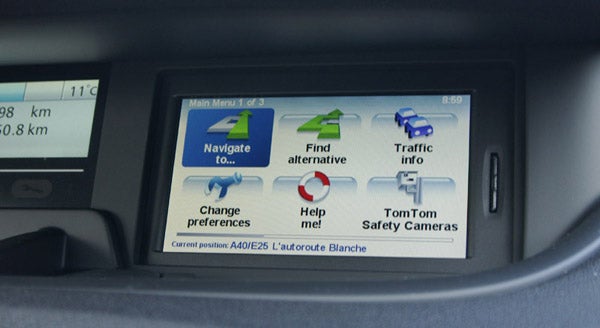
Given the enormous price differential, you’d think the TomTom nav was both the obvious choice and immensely good value. In practice it mostly is and yet still left us a little disappointed. The biggest downer is the low specification of the system. It lacks many of the snazzier features of the best aftermarket TomTom units such as HD Traffic and Live services, the likes of which can be had on TomTom’s own satnav devices from as little as £275. Renault told us that it’s early days for its partnership with TomTom and that we can expect full-featured TomTom systems to appear in future.
The system’s graphical interface also clashes with that of the virtual instrument cluster. Combined with the split control interfaces and the two oddly shaped LCD panels sitting uncomfortably together under the main binnacle, the overall feeling is of a system that has been tacked on as an afterthought.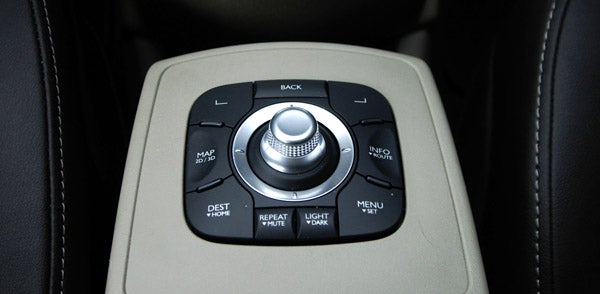
However, that’s not to say it doesn’t have any benefits. Because it’s a fully integrated system, it’s able to mute the main stereo system when delivering voice guidance, for instance. What’s more, it not only supports map and custom POI updates via an SD memory card. Users can also use the SD card slot to upload multi-waypoint journeys prepared on a PC into the satnav system.
For the record, the Grand Scenic also comes with a Bluetooth phone kit including the obligatory support for contact databases. It’s standard on the Dynamique trim level and upwards and a £200 option when combined with the upgraded USB-enabled sound system on the remainder of the Grand Scenic range.
In car-tech aside, the big news with the latest Grand Scenic is improved accommodation. The really important feature is seating and here Renault has strived to make the Grand Scenic more spacious and flexible. All three of the second row seats slide and adjust individually. Moreover, Renault claims a best-in-class 275mm of knee room for second row occupants and 102mm for those seated in the optional third row. Renault also reckons that the third row seats are more comfortable, less upright and offer more headroom than the competition. Nevertheless, we found they remain rather more suitable for kids than adults.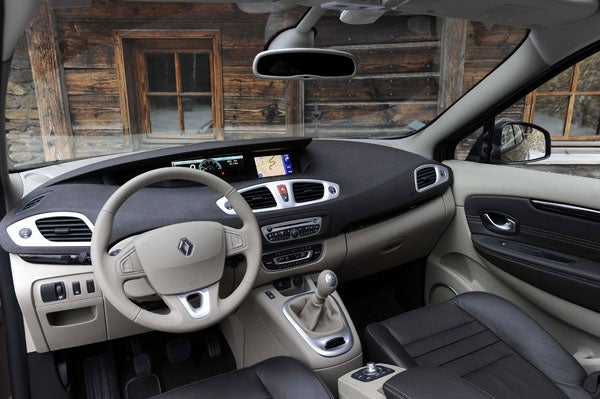
As you would expect, the rear two rows of seats are highly configurable enabling varying quantities of luggage space. Boot space clocks in at 208 litres with all seven seats in use, 564 to 702 in five-seat mode and an epic 2,063 with the second and third rows removed or folded flat. With no less than 40 storage compartments, it’ll also swallow the huge array of paraphernalia that any family road trip inevitably generates.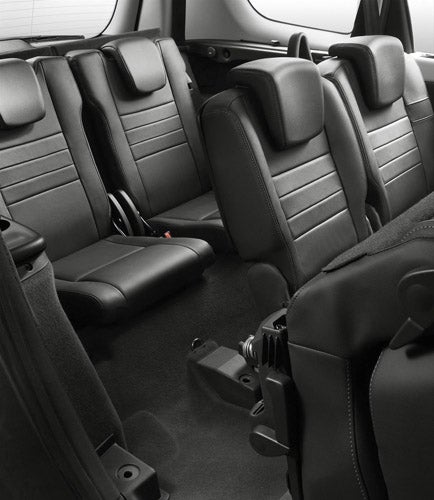
Further options of interest include the split/sliding panoramic sunroof and the rear mounted parking camera. Renault charges £600 for the sunroof and if you can stretch to it we reckon it’s well worth the money for the sense of spaciousness and airiness it brings to the cabin. As for the parking camera, it wasn’t fitted to any of the test cars at the launch. Keyless go is also a £275 option on low end models (it’s standard on most mid-range and up Grand Scenics) while Xenon headlamps can be had for £650. Note that it’s worth looking out for the option packs that shave a few pounds off the overall cost of selecting various extras individually. 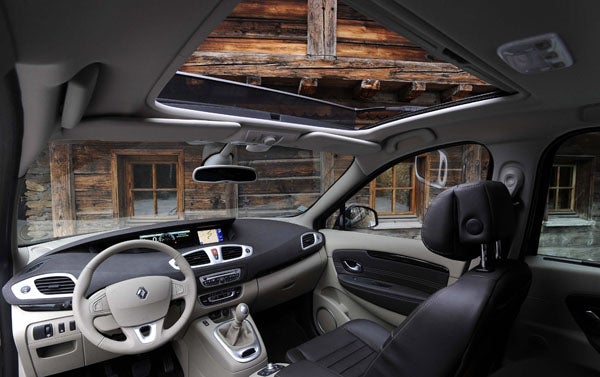
Of course, this is a Renault so it’s packed with safety features. ESP, EBA, ABS – the usual alphabet soup of stability control and brake enhancement technologies all make an appearance as do an army of adaptive airbags including curtain airbags triggered by side impact sensors that protect front and second row passengers from head injuries.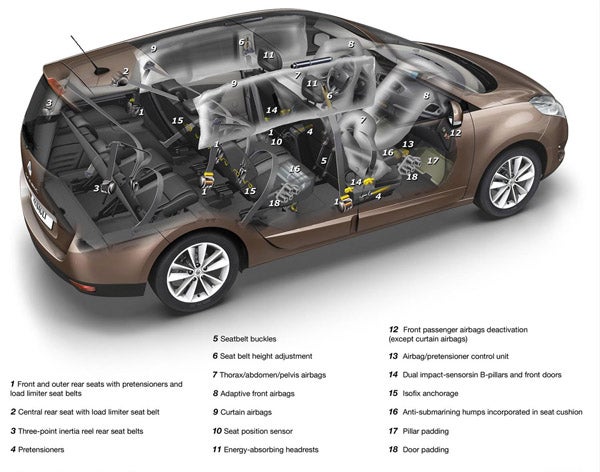
Renault also claims the new Grand Scenic’s taller, wider windscreen gives drivers a superior view of the road, though we found that the blind spots from the A-pillars at junctions had been repositioned rather than eradicated. Nevertheless, should the worse happen we doubt there’s a car in this segment that would offer better protection given Renault’s strong track record in crash safety.
Overall the new Scenic is spacious, substantial vehicle and certainly feels a class above the Megane hatch upon which it is based. That’s particularly true of the 2.0L diesel dCi 160 test car which had the full £900 leather interior complimenting the standard soft-touch interior plastics. The result is a surprisingly up market interior ambience, so long as you don’t inspect the detail trimmings too carefully.
For any MPV, comfort inevitably takes priority over outright dynamics. However, with the latest Grand Scenic, Renault has decided to shift the balance slightly in favour of handling. Saloon levels of body control are the target and the tools are stiffer subframe mounts, tweaks to the steering and much stiffer anti-roll bars. In terms of body roll during the cornering, it’s certainly mission accomplished. You can throw the Grand Scenic into corners as hard as you like, roll remains very well controlled for this type of vehicle. So while it’s unlikely that many owners will give this car a proper thrashing, but there’s no doubting it’s up to the job.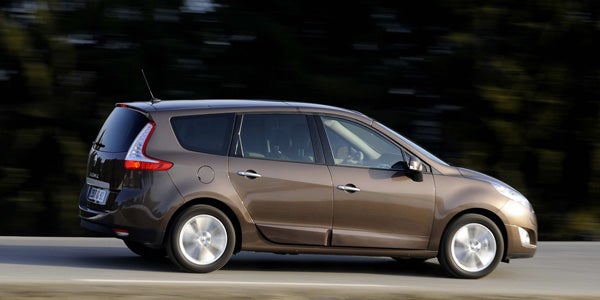
However, the downside is ride quality that suffers occasional choppiness. The car’s springing and damping remains very much comfort orientated, so full-width transverse lumps and humps are still handled with aplomb. But thanks to those stiff anti-roll bars, pot holes and other laterally asymmetric surface imperfections (i.e. bumps – ed) smoothed out as much as you’d hope. Hence, while the tighter roll control certainly makes the new Grand Scenic a much more effective vehicle for covering ground at pace, we wonder whether buyers would prefer the chassis was optimised for maximum comfort.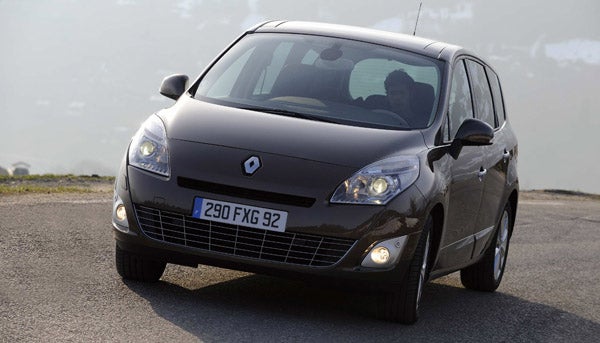
More in tune with the Grand Scenic’s overall remit are the two engine options available at the launch event. The torque, free revving power delivery of the refined new 130hp 1.4L petrol turbo engine in the TCe 130, which is based on a four-cylinder Nissan unit, suits the car perfectly and combines with a new sound-deadening plastic floor coating to deliver impressive noise suppression. Rated at 42.8mpg for the combined cycle, it’s also adequately economical.
The 160hp 2L turbodiesel option is not quite so well isolated, but does provide a bit more shove along with superior 50.4mpg consumption on the combined cycle. However, it doesn’t feel capable of anything like the 280lb/ft official torque output, perhaps because in 2.0L diesel trim the Grand Scenic rocks the scales at a hefty 1,628kg.
If you’ve read this far you’ll know the new Grand Scenic is largely a success. It is bigger and better all round compared to the outgoing model and benefits from a well specified infotainment system with an intriguing TomTom navigation twist, even if it does suffer a few flaws involving the control interfaces and display quality. The car’s handling has also been tightened up, though somewhat at the expense of ride comfort. What’s more, Renault has successfully lifted the latest Grand Scenic up a notch or two in terms of perceived quality inside and out.
However, we do have one major bone to pick. Every single test car at the launch event had a manual gearbox. On the 1.4L petrol turbo model which starts at £17,595 in entry-level Expression trim, that’s just about acceptable. But we find it hard to imagine many customers purchasing the 2.0L diesel model would really want to change their own gears – this is a family MPV, not a sportscar, after all. And for £21,495, we don’t think they should have to.
For the record, therefore, if we were buying a new Grand Scenic, our preference would be to go with the seven-seater Privilege TCe 130 with the impressive new 1.4L petrol turbo engine, which comes with bi-zone climate and parking sensors as standard. To that we’d add the Comfort Pack with the panoramic sunroof and TomTom nav for £900, bringing the on the road price to £20,695. We’d probably have a go at convincing our Renault dealer to throw in the leather seats gratis. The resulting car would be an effective and comfortable family workhorse.
Or at least it would be if it was available with an automatic gearbox. But it’s not. The only non-manual options are the decidedly sub-optimal 140hp non-turbo 2.0L petrol with a CVT box or the painfully expensive 2.0L diesel, detuned to 150hp and mated to a conventional automatic transmission. The latter starts at £23,695 in Privilege trim, which is pretty astonishing for a car based on a Megane platform.
Admittedly, the pricing and availability of the Grand Scenic’s automatic and CVT gearboxes are very much in line with the competition in this segment. You’ll pay dearly if you specify the Citroen Grand C4 Picasso or Vauxhall’s Zafira with one of the few non-manual gearbox options available on either. Nevertheless, we reckon the first company to break the deadlock and make a more affordable automatic option available will be onto a real winner.

